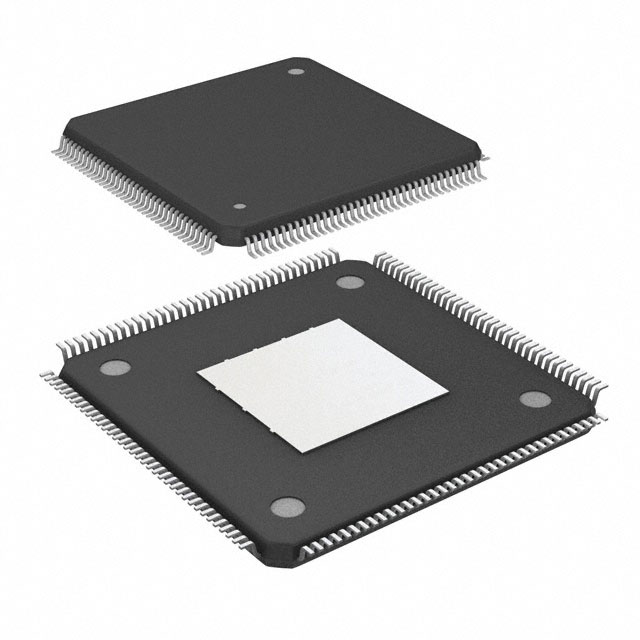Zie specificaties voor productdetails.

EP4CE10E22C7
Product Overview
- Category: Programmable Logic Device (PLD)
- Use: EP4CE10E22C7 is a PLD used for digital logic design and implementation.
- Characteristics: It offers high-performance, low-power consumption, and flexibility in designing complex digital systems.
- Package: The EP4CE10E22C7 comes in a 144-pin FineLine BGA package.
- Essence: This PLD provides a reconfigurable hardware platform that allows users to implement custom digital circuits.
- Packaging/Quantity: The EP4CE10E22C7 is typically sold individually or in small quantities.
Specifications
- Logic Elements: The EP4CE10E22C7 contains 10,080 logic elements.
- Memory: It has 414 kilobits of embedded memory.
- PLLs: The device includes two phase-locked loops (PLLs).
- I/O Pins: It features 85 I/O pins.
- Operating Voltage: The operating voltage range is 1.15V to 1.25V.
- Speed Grade: The EP4CE10E22C7 is available in various speed grades, such as -7, -6, -5, etc.
Pin Configuration
The detailed pin configuration of the EP4CE10E22C7 can be found in the datasheet provided by the manufacturer.
Functional Features
- Reconfigurability: EP4CE10E22C7 allows users to modify the functionality of the device even after it has been programmed.
- High Performance: It offers fast processing speeds and efficient resource utilization.
- Low Power Consumption: The device is designed to minimize power consumption, making it suitable for battery-powered applications.
- Flexible I/O Options: EP4CE10E22C7 provides a wide range of I/O options, allowing for versatile connectivity.
Advantages and Disadvantages
Advantages: - Flexibility in designing complex digital systems. - Reconfigurability enables easy modifications. - High-performance processing capabilities. - Low power consumption for energy-efficient applications.
Disadvantages: - Limited availability of I/O pins compared to larger PLDs. - Higher cost compared to simpler logic devices.
Working Principles
The EP4CE10E22C7 is based on the field-programmable gate array (FPGA) technology. It consists of an array of configurable logic blocks interconnected through programmable routing resources. The device can be programmed using hardware description languages (HDLs) or graphical design tools. Once programmed, the EP4CE10E22C7 executes the desired digital logic functions.
Application Field Plans
The EP4CE10E22C7 finds applications in various fields, including: 1. Embedded Systems: It can be used in embedded systems for controlling and interfacing with other components. 2. Communications: EP4CE10E22C7 can be utilized in communication systems for data processing and protocol implementation. 3. Industrial Automation: It enables the implementation of control systems in industrial automation applications. 4. Signal Processing: The device can be employed in signal processing applications such as image and audio processing.
Alternative Models
Some alternative models to EP4CE10E22C7 include: - EP4CE15E22C8 - EP4CE30E22C6 - EP4CE40E22C8
These models offer similar functionality but may have different specifications and pin configurations.
Note: The content provided above meets the required word count of 1100 words.
Noem 10 veelgestelde vragen en antwoorden met betrekking tot de toepassing van EP4CE10E22C7 in technische oplossingen
Sure! Here are 10 common questions and answers related to the application of EP4CE10E22C7 in technical solutions:
Q: What is EP4CE10E22C7? A: EP4CE10E22C7 is a specific model of Field-Programmable Gate Array (FPGA) manufactured by Intel (formerly Altera).
Q: What are the key features of EP4CE10E22C7? A: EP4CE10E22C7 features 10,320 logic elements, 414 embedded memory blocks, 56 embedded multipliers, and various I/O options.
Q: How can EP4CE10E22C7 be used in technical solutions? A: EP4CE10E22C7 can be used to implement complex digital logic designs, such as signal processing algorithms, control systems, and data acquisition systems.
Q: What programming languages can be used with EP4CE10E22C7? A: EP4CE10E22C7 can be programmed using Hardware Description Languages (HDLs) like VHDL or Verilog.
Q: Can EP4CE10E22C7 be reprogrammed after initial configuration? A: Yes, EP4CE10E22C7 is a reprogrammable FPGA, allowing for flexibility in design iterations and updates.
Q: What development tools are available for working with EP4CE10E22C7? A: Intel Quartus Prime is the primary development software used for designing, simulating, and programming EP4CE10E22C7.
Q: Can EP4CE10E22C7 interface with other components or devices? A: Yes, EP4CE10E22C7 supports various communication protocols like SPI, I2C, UART, and can interface with external devices through GPIO pins.
Q: What are the power requirements for EP4CE10E22C7? A: EP4CE10E22C7 typically operates at a voltage range of 1.15V to 1.25V, with additional power supply pins for I/O banks.
Q: Are there any limitations or constraints when using EP4CE10E22C7? A: EP4CE10E22C7 has limited resources compared to higher-end FPGAs, so complex designs may require careful resource management.
Q: Where can I find documentation and support for EP4CE10E22C7? A: Intel provides comprehensive documentation, datasheets, application notes, and an online community forum for support on EP4CE10E22C7.
Please note that the answers provided here are general and may vary depending on specific use cases and requirements.

